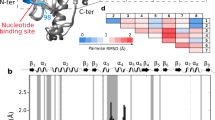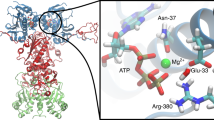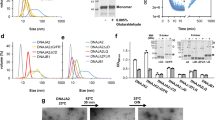Abstract
It is not currently known in what state (folded, unfolded or alternatively folded) client proteins interact with the chaperone Hsp90. We show that one client, the p53 DNA-binding domain, undergoes a structural change in the presence of Hsp90 to adopt a molten globule–like state. Addition of one- and two-domain constructs of Hsp90, as well as the full-length three-domain protein, to isotopically labeled p53 led to reduction in NMR signal intensity throughout p53, particularly in its central β-sheet. This reduction seems to be associated with a change of structure of p53 without formation of a distinct complex with Hsp90. Fluorescence and hydrogen-exchange measurements support a loosening of the structure of p53 in the presence of Hsp90 and its domains. We propose that Hsp90 interacts with p53 by multiple transient interactions, forming a dynamic heterogeneous manifold of conformational states that resembles a molten globule.
This is a preview of subscription content, access via your institution
Access options
Subscribe to this journal
Receive 12 print issues and online access
$189.00 per year
only $15.75 per issue
Buy this article
- Purchase on Springer Link
- Instant access to full article PDF
Prices may be subject to local taxes which are calculated during checkout





Similar content being viewed by others
References
Pratt, W.B. & Toft, D.O. Steroid receptor interactions with heat shock protein and immunophilin chaperones. Endocr. Rev. 18, 306–360 (1997).
Richter, K. & Buchner, J. Hsp90: chaperoning signal transduction. J. Cell. Physiol. 188, 281–290 (2001).
Terasawa, K., Minami, M. & Minami, Y. Constantly updated knowledge of Hsp90. J. Biochem. 137, 443–447 (2005).
Shiau, A.K., Harris, S.F., Southworth, D.R. & Agard, D.A. Structural analysis of E. coli hsp90 reveals dramatic nucleotide-dependent conformational rearrangements. Cell 127, 329–340 (2006).
Ali, M.M. et al. Crystal structure of an Hsp90-nucleotide-p23/Sba1 closed chaperone complex. Nature 440, 1013–1017 (2006).
Vaughan, C.K. et al. Structure of an Hsp90–Cdc37–Cdk4 complex. Mol. Cell 23, 697–707 (2006).
Hawle, P. et al. The middle domain of Hsp90 acts as a discriminator between different types of client proteins. Mol. Cell. Biol. 26, 8385–8395 (2006).
Soussi, T., Legros, Y., Lubin, R., Ory, K. & Schlichtholz, B. Multifactorial analysis of p53 alteration in human cancer: a review. Int. J. Cancer 57, 1–9 (1994).
Vogelstein, B., Lane, D. & Levine, A.J. Surfing the p53 network. Nature 408, 307–310 (2000).
Blagosklonny, M.V., Toretsky, J., Bohen, S. & Neckers, L. Mutant conformation of p53 translated in vitro or in vivo requires functional HSP90. Proc. Natl. Acad. Sci. USA 93, 8379–8383 (1996).
Whitesell, L., Sutphin, P.D., Pulcini, E.J., Martinez, J.D. & Cook, P.H. The physical association of multiple molecular chaperone proteins with mutant p53 is altered by geldanamycin, an hsp90-binding agent. Mol. Cell. Biol. 18, 1517–1524 (1998).
Müller, L., Schaupp, A., Walerych, D., Wegele, H. & Büchner, J. Hsp90 regulates the activity of wild type p53 under physiological and elevated temperatures. J. Biol. Chem. 279, 48846–48854 (2004).
Cañadillas, J.M.P. et al. Solution structure of p53 core domain: Structural basis for its instability. Proc. Natl. Acad. Sci. USA 103, 2109–2114 (2006).
Mulder, F.A.A., Ayed, A., Yang, D.W., Arrowsmith, C.H. & Kay, L.E. Assignment of 1HN, 15N, 13Cα, 13CO and 13Cβ resonances in a 67 kDa p53 dimer using 4D-TROSY NMR spectroscopy. J. Biomol. NMR 18, 173–176 (2000).
Martinez-Yamout, M.A. et al. Localization of sites of interaction between p23 and Hsp90 in solution. J. Biol. Chem. 281, 14457–14464 (2006).
Eliezer, D., Jennings, P.A., Dyson, H.J. & Wright, P.E. Populating the equilibrium molten globule state of apomyoglobin under conditions suitable for characterization by NMR. FEBS Lett. 417, 92–96 (1997).
Eliezer, D., Chung, J., Dyson, H.J. & Wright, P.E. Native and non-native structure and dynamics in the pH 4 intermediate of apomyoglobin. Biochemistry 39, 2894–2901 (2000).
Baum, J., Dobson, C.M., Evans, P.A. & Hanley, C. Characterization of a partly folded protein by NMR methods: studies on the molten globule state of guinea pig α-lactalbumin. Biochemistry 28, 7–13 (1989).
Redfield, C., Smith, R.A.G. & Dobson, C.M. Structural characterization of a highly-ordered 'molten globule' at low pH. Nat. Struct. Biol. 1, 23–29 (1994).
Schulman, B.A., Kim, P.S., Dobson, C.M. & Redfield, C. A residue-specific NMR view of the non-cooperative unfolding of a molten globule. Nat. Struct. Biol. 4, 630–634 (1997).
Greene, L.H., Wijesinha-Bettoni, R. & Redfield, C. Characterization of the molten globule of human serum retinol-binding protein using NMR spectroscopy. Biochemistry 45, 9475–9484 (2006).
Cattoni, D.I., Kaufman, S.B. & Gonzalez Flecha, F.L. Kinetics and thermodynamics of the interaction of 1-anilino-naphthalene-8-sulfonate with proteins. Biochim. Biophys. Acta 1794, 1700–1708 (2009).
Bai, Y., Sosnick, T.R., Mayne, L. & Englander, S.W. Protein folding intermediates: Native-state hydrogen exchange. Science 269, 192–197 (1995).
Paterson, Y., Englander, S.W. & Roder, H. An antibody binding site on cytochrome c defined by hydrogen exchange and two-dimensional NMR. Science 249, 755–759 (1990).
Schanda, P., Kupce, E. & Brutscher, B. SOFAST-HMQC experiments for recording two-dimensional heteronuclear correlation spectra of proteins within a few seconds. J. Biomol. NMR 33, 199–211 (2005).
Rüdiger, S., Freund, S.M., Veprintsev, D.B. & Fersht, A.R. CRINEPT-TROSY NMR reveals p53 core domain bound in an unfolded form to the chaperone Hsp90. Proc. Natl. Acad. Sci. USA 99, 11085–11090 (2002).
Pratt, W.B., Morishima, Y., Murphy, M. & Harrell, M. Chaperoning of glucocorticoid receptors. Handb. Exp. Pharmacol. 2006, 111–138 (2006).
Koradi, R., Billeter, M. & Wüthrich, K. MOLMOL: a program for display and analysis of macromolecular structures. J. Mol. Graph. 14, 51–55 (1996).
Rippin, T.M., Freund, S.M., Veprintsev, D.B. & Fersht, A.R. Recognition of DNA by p53 core domain and location of intermolecular contacts of cooperative binding. J. Mol. Biol. 319, 351–358 (2002).
Yamazaki, T., Lee, W., Arrowsmith, C.H., Muhandiram, D.R. & Kay, L.E. A suite of triple-resonance NMR experiments for the backbone assignment of 15N, 13C, 2H labeled proteins with high sensitivity. J. Am. Chem. Soc. 116, 11655–11666 (1994).
Grzesiek, S. & Bax, A. Improved 3D triple-resonance NMR techniques applied to a 31 kDa protein. J. Magn. Reson. 96, 432–440 (1992).
Wittekind, M. & Mueller, L. HNCACB, a high-sensitivity 3D NMR experiment to correlate amide-proton and nitrogen resonances with the alpha- and beta-carbon resonances in proteins. J. Magn. Reson. 101, 201–205 (1993).
Wong, K.B. et al. Hot-spot mutants of p53 core domain evince characteristic local structural changes. Proc. Natl. Acad. Sci. USA 96, 8438–8442 (1999).
Johnson, B.A. & Blevins, R.A. NMRView: a computer program for the visualization and analysis of NMR data. J. Biomol. NMR 4, 604–613 (1994).
Acknowledgements
We thank M. Kostic for preparation of p53 and Hsp90 expression constructs and preliminary binding assays. We thank P. Wright and members of the Wright and Dyson groups for helpful comments, G. Kroon for help with NMR experiments and E. Manlapaz for technical assistance. The original clone used to prepare the domains of human Hsp90α was provided by D. Toft of the Mayo Clinic (Rochester, Minnesota, USA). This work was supported by grant GM57374 from the US National Institutes of Health, and by a grant from the Korea Research Foundation (KRF-2006-214-E0009), funded by the Korean Government (MOEHRD).
Author information
Authors and Affiliations
Contributions
S.J.P. and H.J.D. designed experiments; S.J.P. carried out NMR and fluorescence experiments; B.N.B. carried out H/D exchange experiments; S.J.P., M.A.M.-Y. and H.J.D. analyzed data; S.J.P., M.A.M.-Y. and H.J.D. wrote the paper.
Corresponding author
Ethics declarations
Competing interests
The authors declare no competing financial interests.
Supplementary information
Supplementary Text and Figures
Supplementary Figures 1–5, Supplementary Table 1 and Supplementary Discussion (PDF 592 kb)
Rights and permissions
About this article
Cite this article
Park, S., Borin, B., Martinez-Yamout, M. et al. The client protein p53 adopts a molten globule–like state in the presence of Hsp90. Nat Struct Mol Biol 18, 537–541 (2011). https://doi.org/10.1038/nsmb.2045
Received:
Accepted:
Published:
Issue Date:
DOI: https://doi.org/10.1038/nsmb.2045
This article is cited by
-
Combination of AURKA inhibitor and HSP90 inhibitor to treat breast cancer with AURKA overexpression and TP53 mutations
Medical Oncology (2022)
-
Molecular chaperones and their denaturing effect on client proteins
Journal of Biomolecular NMR (2021)
-
Structural ensemble-based docking simulation and biophysical studies discovered new inhibitors of Hsp90 N-terminal domain
Scientific Reports (2018)
-
Isolation and characterization of a minimal building block of polyubiquitin fibrils
Scientific Reports (2018)
-
HSP90 recognizes the N-terminus of huntingtin involved in regulation of huntingtin aggregation by USP19
Scientific Reports (2017)



